![]()
Alone in his cabin, nearly every day for seven months, Christopher Columbus wrote down the details of his first voyage to the New World. Large parts of his painstaking work have been lost. Other large parts remain, for historians to read and to ponder. The largest and most important of these is the abstraction, done by Bartolome de Las Casas, known as the Diario.
There has been speculation for many years that the distance measurements in the Diario are unreliable, primarily because of the unit conversions done by Las Casas. In particular, debate has centered on the unit of measure used by Columbus as he wrote: did Columbus measure distance in miles, or in leagues? Close examination of the historical record, combined with mathematical analysis of the distance measurements in the log, can now provide new answers to some troublesome old questions.
I have subtitled this talk "The Final Verdict." But the verdict is not mine to render, it is yours. You, as historians, are the final judges of historical truth. And although the evidence I will present to you is overwhelming, all I ask is that you listen without prejudice, and make your judgment fairly.
When he returned to Spain in 1493, Columbus reported to the royal court at Barcelona, and gave his original log to the Sovereigns. Queen Isabela ordered the log to be copied, resulting in the so-called Barcelona Copy. The original has not been seen since, but the Barcelona Copy was returned to Columbus prior to his second voyage later that year, and remained in his possession until his death in 1506. It then passed into the hands of his heirs, but it too was lost sometime after 1554.
 |
Before that time, however, much of the contents of the Barcelona
Copy was abstracted by Las Casas into the Diario. This
abstraction was part of the research program that eventually led to his
massive work, the Historia de las Indias. The Diario
remains our primary historical record of the first voyage of
Columbus.
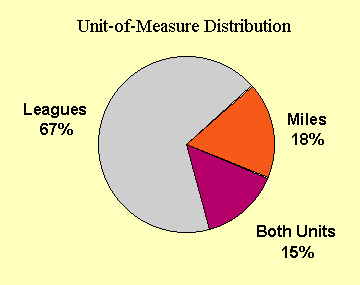 |
It contains about three hundred fifty distance measurements, most of which are given in leagues, some of which are in miles, and some of which are in both units. Significantly, there are about a dozen places where Las Casas had written the word 'leagues,' then crossed out 'leagues' and substituted 'miles.' This leads to the conclusion that in at least some cases, Las Casas could not have been copying these distances directly from his source, but rather must have been converting from one unit to the other as he wrote. The distances given in both units show that this conversion was done at a ratio of four miles to one league.
The significance of this conclusion rests primarily in the debate
over the first landfall of Columbus. In particular, the Diario
tells us that the second island visited by Columbus had a coastline
running north-south for five leagues, and another running east-west for
ten leagues or more. But many now suppose that Rum Cay in the Bahamas
was this island, and Rum Cay is only about five miles north-south and
ten or more miles east-west.
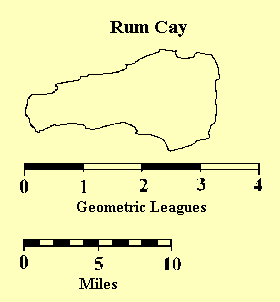 |
If Columbus wrote in leagues, the dimensions given in the Diario are presumably original with him and therefore correct. But if Columbus wrote in miles, it's possible that he could have written 'five miles' and 'ten miles' in the original, and that Las Casas, while habitually converting into leagues, wrote 'leagues' by mistake without changing the numbers.
It is primarily this supposition that has allowed Rum Cay to be repeatedly advocated as a part of Columbus's route by various historians for more than a century. And there are also other places where similar types of errors have been assumed.
Once evidence against this idea is that the Diario speaks in
two voices: in most of the text, Las Casas writes in third person. But
in some portions, Las Casas quotes the Admiral directly (or at least he
claims to do so), switching to Columbus's first person narrative. That
portion of the log that describes the Bahamian islands is entirely in
first person, and Las Casas claims that the Bahamian portion is a
direct quote from the Admiral. But none of the canceled 'leagues' cases
occurs in the first person (direct quote) portions. This implies that
the unit conversions were occurring only in the abstracted third-person
portions.
 |
In the first person portions, there are fifteen distances in leagues
only, one distance in both units, and none in miles only. So if the
first person portions are indeed direct quotes, Columbus's original
writing must have been predominantly in leagues.
 |
Further, there were actually two people who both saw the Barcelona Copy and reported on its contents. The first was of course Las Casas; the second was the Admiral's son Fernando Colon, who wrote a biography of his father that was published in Venice in 1571.
Although Fernando's Spanish manuscript has not survived, it was rendered into Italian by Alfonso Ulloa, a Spaniard making his living in Venice as a professional translator. This document is now known as the Historie.
We know that Fernando also used the Barcelona Copy (and not the Diario) as his original source, because the biography contains many details of the first voyage which could only have come from the Admiral himself, and which are absent from the Diario.
Like the Diario, Fernando's biography also reports that the coastlines of the second island were five leagues north-south and ten or more leagues east-west. Since both men could not have made exactly the same errors in exactly the same places, it is certain that the Barcelona Copy must have contained these dimensions as given in leagues, and that they were copied correctly in both cases.
Interestingly, the first voyage sections of the biography contain over fifty distance measurements, including direct quotes from the Barcelona Copy, and they are all given in leagues. And since the biography, unlike the Diario, contains no evidence of unit conversions, this also indicates that the Barcelona Copy itself was written in leagues.
Of course, even if the Barcelona Copy were written in leagues as the evidence indicates, there remains the possibility that Columbus himself wrote in miles, and a conversion into leagues was done by the court copyists at Barcelona. At first glance, this speculation seems weak: these copyists were most likely clerics who would have sworn an oath to copy what was given them exactly. Further, the Barcelona Copy contained navigational data vital to the safety of the second voyage, so tampering with that data would have been foolhardy.
And there are two other ways we can attack the problem of original units. First, when we examine other writings of Columbus (outside of the first voyage log and its derivatives), we find that he had a distinct personal preference for using leagues rather than miles, and by a huge margin.
Source |
Leagues |
Miles |
| Letter to Santangel of 1493-2-15 | 8 | 0 |
| Letter to the Sovereigns of 1493-3-4 | 5 | 0 |
| Letter to the Sovereigns of 1495-1-30 | 2 | 0 |
| Will of 1498-2-22 | 4 | 0 |
| Journal of the Third Voyage, 1498 | 33 | 1 |
| Letter to the Sovereigns of 1498-10-18 | 13 | 5 |
| Letter to De la Torre of 1500 | 1 | 0 |
| Letter to Pope Alexander VII, 1502 | 2 | 1 |
| Letter to the Sovereigns of 1503-7-7 | 9 | 2 |
| Will of 1506-5-19 | 1 | 0 |
Totals |
78 |
9 |
This list represents every complete document that Columbus wrote in his lifetime that contains distance measurements, and that has been translated into English. In spite of the fact that most of these documents were written to non-nautical audiences, Columbus favors leagues by 90 percent. And the actual ratio may be even greater, since many of the mile usages are disputable cases.
Second, there is a way we can firmly settle the question of the
direction in which the unit conversions occurred, by examining the
distribution of numbers in the measurements themselves. Those distances
given in both units would seem to present a chicken-and-egg problem,
but the miles-only and leagues-only measurements are more easily
tractable: we can assume that only one of these two number groups is a
set of original measurements and estimates, while the other is a set of
calculation results. And numerical analysis can tell us which is
which.
 |
When people measure things, there is a natural tendency to round numbers. In particular, people prefer to use integers rather than fractions. But when fractions are used, there is a tendency to prefer the fraction 1/2 (and fractional numbers ending in 1/2) over all other fractions. So, if the league numbers are original measurements, they should look like the numbers in the left-hand column on the slide: most should be integers, and of those that are fractions, most should end in 1/2.
 |
But suppose that the league numbers had been converted from miles by dividing the mile numbers by four. In that case, the mile numbers would look like the original numbers in the left hand column, and the league numbers would look like the right-hand column: no more than a quarter of the converted league numbers should be integers, because no more than a quarter of the original mile numbers would have been evenly divisible by four to begin with. By the same reasoning, of those converted league numbers which are fractions, only a third (or less) should be fractions ending in 1/2, another third should be fractions ending in 1/4, and most of the rest should be fractions ending in 3/4.
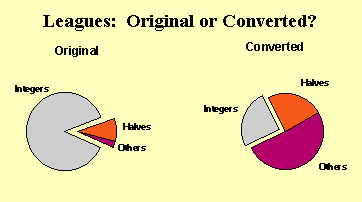 |
In other words, these two hypotheses about the league measurements give vastly different predictions of the distribution of numbers in the measurements themselves. The original-measurement hypothesis predicts mostly integers, while the converted-from-miles hypothesis predicts mostly fractional endings. Further, of the fractional numbers, the original-measurement hypothesis predicts mostly halves, while the converted-from-miles hypothesis predicts mostly fractions other than one-half.
And when we examine the actual distribution of league numbers in the
Diario, we find that 200 out of 236 are integers, and of the
remainder, 28 out of 36 are fractions ending in 1/2. This is exactly
what we would expect from a set of original measurements, but it does
not meet our expectations of league numbers derived from miles.
 |
Turning now to the miles-only numbers, we can apply the same logic.
Original mile numbers should look like the numbers in the left hand
column on the slide: mostly integers, but they should also be evenly
distributed. That means about a quarter should be multiples of four;
and of those not multiples of four, two-thirds should be odd numbers
and one-third should be even.
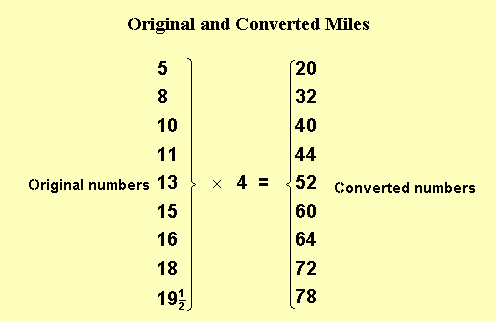 |
But suppose the mile numbers were derived from original measurements
in leagues, by multiplying the league numbers by four. In that case,
the original league numbers should look like the left hand column, and
the converted mile numbers should look like the right hand column: most
of the converted mile numbers should be multiples of four, and of those
not multiples of four, most should be even -- because, when you take a
fraction ending in 1/2 and multiply by 4, you get an even number.
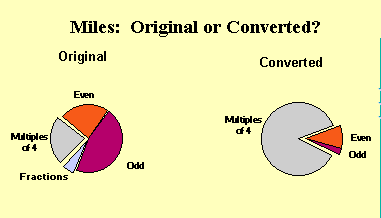 |
Once again, the two hypotheses about the mile measurements give vastly different predictions about the distribution of numbers in the measurements themselves. The original-measurement hypothesis predicts about 25% multiples of four, while the converted-from-leagues hypothesis predicts a large majority of multiples of four. Further, of those numbers which are not multiples of four, the original-measurement hypothesis predicts mostly odd numbers, while the converted-from-leagues hypothesis predicts mostly even numbers.
And when we examine the actual distribution of mile numbers in the
Diario, we find that 49 out of 62 are multiples of four, and of
the remainder, seven out of thirteen are even. This is exactly what we
would expect if the mile numbers had been converted from original
measurements in leagues. In fact, it cannot be explained in any other
way. The reason the mile numbers are multiples of four, is that they
were multiplied by four; which means they were originally leagues. The
probability that this distribution could occur by chance is less than
one in a hundred quintillion.
 |
Now a question naturally arises. Nearly everyone believes that Columbus measured his speed in miles per hour. And in his dead reckoning navigation, he must have commonly found his distance run by a time and speed calculation, based on his miles per hour speeds. So wouldn't that require that Columbus find his distance in miles first, because the speeds were in miles per hour?
The answer, surprisingly, is no. There is a mathematical shortcut, that Columbus could have used, that actually makes it faster and easier to reckon in leagues from speeds recorded in miles per hour. Let's see how this works.
Suppose on a given night the ship goes 6 miles per hour for 3 hours, then 5 miles per hour for 5 hours, then 4 miles per hour for 4 hours. What is the total distance run during the night? (Now, I don't always want to be seeing the same hands!)
To reckon in miles, we multiply 6 miles per hour times 3 hours, which is 18 miles, and we remember that number. Then we multiply 5 times 5, which is 25 miles, and remember that number. Then we multiply 4 times 4, which is 16 miles, and remember that number. Then we add the remembered numbers: 18 plus 25 is 43 miles, and 43 plus 16 is 59 miles, which is the answer. But that's a lot of math to get there.
Reckoning in leagues is easier. First, Columbus mentally divides the night into three watches of four hours each. Sailors regulate their time and their work in four-hour watches, so it's natural for Columbus to think in these terms. For each watch, Columbus makes a rough and ready estimate of the average speed during the watch. So for the first four-hour watch, Columbus estimates an average speed of 6 miles per hour. (It's really a fraction less, but Columbus ignores the fraction.) In the second watch, the speed is 5 miles per hour, and in the last watch the speed is 4 miles per hour. Then Columbus adds the speeds: 6 plus 5 plus 4, to get 15. And that's the answer: 15 leagues.
Reckoning in leagues is easier than reckoning in miles, since there is no multiplication. The addition is easy, too, since the numbers are small when reckoning in leagues. And the results are predominantly integer number leagues, just as we expect, because rounding to integers is a natural part of the process.
One final important point. We previously excluded from our analysis those measurements that were given in both leagues and miles. When we look now at these measurements, we discover a curious fact. First, we find the usual excess of multiples-of-four miles associated with the conversion from leagues into miles. But more interestingly, we also find an excess of fractional league numbers, which we had previously said would show a conversion from miles into leagues.
 |
Also, we find that this excess of fractional league numbers is strongly clustered in the month of February 1493, on the return voyage. To be precise, there is a period in the log, from roughly January 29 through February 25, in which it appears that many of the league numbers were converted from miles -- in the reverse direction of the usual conversion process. Further, this reverse conversion is done only on those distances that describe the length of the ship's daily or nightly run. Distances that are not associated with the ship's run appear to be original, in that they are given only in leagues, and are never fractions.
There are at least two possible explanations for this. First, it may be that Columbus stopped measuring in leagues during this period, and began measuring in miles. But this fails to explain why those distances that do not describe the ship's run do not follow the pattern.
Second, it may be that during this period Columbus omitted many of his summaries of the ship's daily and nightly runs from the log. If Columbus omitted these totals, it would have been possible for Las Casas to reconstruct them from Columbus's speed and time records. But Las Casas probably would not have known about the mariner's league computation shortcut. So his reconstruction, from miles per hour speeds, would probably have been computed in miles first, and then converted into leagues.
This would account for the mile-to-league conversions on the return voyage, and also explains why the non-ships-run distances look like original league numbers.
The reason that this anomalous period on the return voyage is important, is that it shows clearly that all unit conversions, in either direction, are detectable phenomena. The dirty fingerprints of unit conversion are clear and unmistakable. We can tell where unit conversions occur in the Diario, we can tell where they do not occur, and we can tell in which direction they go. And all evidence of unit conversion, in either direction, occurs entirely in the abstracted third person sections of the log.
Here then is a summary of the evidence we have seen.
Given this weight of evidence, I reach the following conclusions:
These are the conclusions that I have reached. These are the conclusions that I want you to reach, too. As I said at the beginning, you are the judges of this case. History awaits your verdict.
![]()
Return to The Columbus Landfall Homepage.
Return to The Columbus Navigation Homepage.